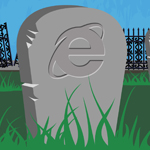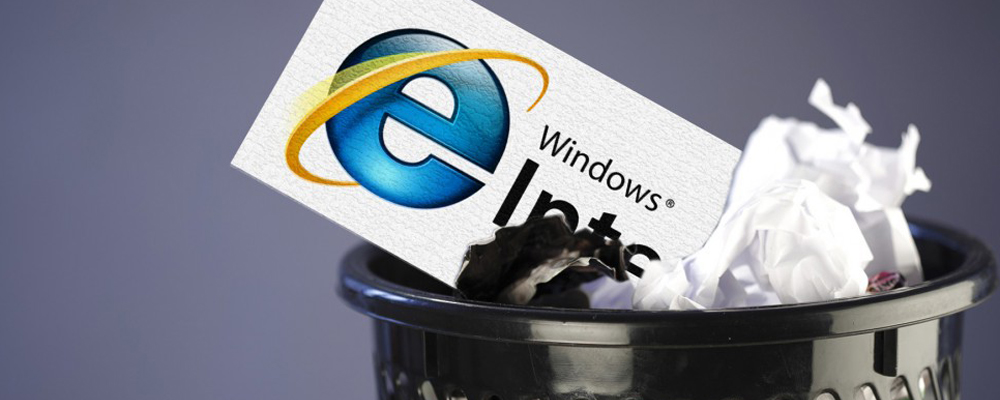 Internet Explorer was once Microsoft's right-hand in getting people to browse the web. When it had virtually no equal competitor, the browser thrived as one of the most popular web browser. When powerful competitors blooms and the trends shifted, its popularity fell. IE has had its chance to get back to the top, but failed to get back to its former glory.
Internet Explorer was once Microsoft's right-hand in getting people to browse the web. When it had virtually no equal competitor, the browser thrived as one of the most popular web browser. When powerful competitors blooms and the trends shifted, its popularity fell. IE has had its chance to get back to the top, but failed to get back to its former glory.
In early 2016, Microsoft is killing Internet Explorer slowly as the Redmond, Washington-based company had enough already.
Internet Explorer was first introduced on August 1995. Since then, the web browser has been included in every version of Windows. After 19 years of existence, in August 2014, Microsoft started setting a date to end supports for old versions of Internet Explorer, and the time was 17 months later.
In January 2016, or 17 months after the initial announcement, Microsoft's deadline has met. When everything is on schedule, Microsoft ends some versions of Internet Explorer as its was to make changes it sees fit.
IE's versions that are having their supports ended are version 8, 9 and 10. Microsoft is releasing a final patch for them to encourage users to upgrade to the company's most recent browsers. The recently announced patch is also pushing an "End of Life" notification.
End of support here means that Microsoft isn't going to provide any patches or security updates for any time in the future. Any technical support for users using those versions is going to stop. Microsoft is prompting those users to take action immediately before the January 12th, 2016.
Starting that date, only the most current version of IE will get security updates and support, said Microsoft. If you don't upgrade, your computer will be more at risks of vulnerable attacks.
Ending The Era Of Internet Explorer
Microsoft in slowly killing Internet Explorer is similar to the company's strategy in killing Windows XP. The company ended the support for its popular operating system to benefit newer versions, such as Windows 7, 8 and mostly 10.
Microsoft wants users to use newer versions of its software while ditching their old ones. The same goes to users using IE 8, 9 and 10.
To individual users, this should not be a huge problem. Microsoft is already having IE 11 for users to use. Windows 7 users, in particular, will have to download and install IE 11. That version is already pre-installed with Windows 8.1.
But if you're that type of user that isn't fond of Microsoft's homemade browser, there are a lot of other alternatives such as Google's Chrome, Mozilla's Firefox and others. As of December 2015, Internet Explorer in overall, had only 23 percent of the browser market in North America and 15 percent worldwide.
The declining market share is the reason why Microsoft sees IE as a product that doesn't fit in the current era.
While most users have less to nothing to lose, the opposite can be felt by corporate users. The end of life for older versions of a software can be disastrous. This can be tough for them especially when they have deeply invested in them. For example, large corporations, bureaucratic institutions and banks. They can be all affected by a huge scale.
The end of Microsoft Windows XP affected many of those entities. And with Microsoft ending supports for older IEs, people were expecting a similar thing.

Because of this particular reason, back in March 2015, Microsoft phased out IE and put older versions of the web browser to "legacy" status, and that means the browsers will still be around mostly for the sake and purpose of enterprise compatibility.
When ordinary users have nothing to lose, and corporate entities may have headaches. The contrast is happening to many web developers and web designers. The news for them may come as a joy. IE browsers tend to "behave" differently if compared to competitor's modern and popular web browsers, and this forces many developers and designers to put extra codes and efforts just to make websites appear and work as designed. Since IE has long been the bane to them and Microsoft is ending their lives slowly, they can expect users using the browsers to decrease and eventually cease.
Microsoft's Windows 10 comes with a new web browser called Edge. When debuted, people have speculated that IE will come to an end. For what reason Microsoft would want to maintain two browsers at the same time if it can pose risks like conflicts with brand names and some other things. The news came true as Microsoft says IE 11 will be the last version of Internet Explorer.
Microsoft Edge which began as Project Spartan, was already meant to be a replacement, not a complementary. Microsoft puts more efforts to make it faster and more streamlined than IE. Edge also includes some new features, such as built-in note taking, easy sharing, the ability to work in several panes without switching around and integration with Microsoft's virtual assistant, Cortana.
Being a newer web browser and under more heavy development process, users can expect many good things. While this is true, the Edge however, still has the IE flaws in some parts of it. But since it's a more modern browser that aims to compete with other popular browsers, it's more flexible and to a margin more desirable. Furthermore, with its development, Edge is still young and has a long way to accomplish the tasks IE couldn't fulfill in its recent life.
Further reading: No More Avoiding. Microsoft's Aggressive Strategy Wants Windows 10 Everywhere